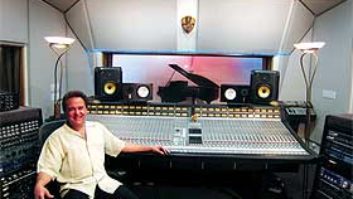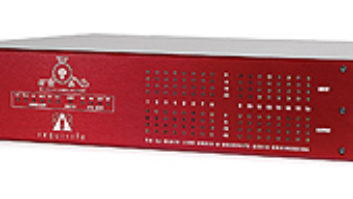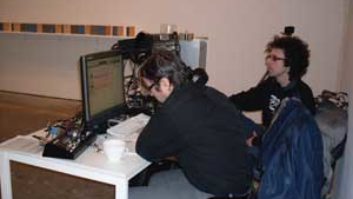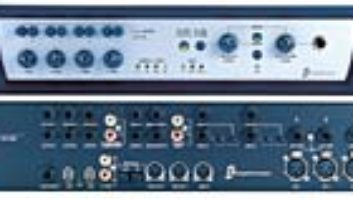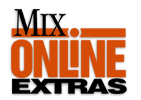
Digidesign’s latest DAW, the 002, is an integratedrecording-to-master control surface and 24-bit/96kHz audio and MIDIinterface/software production package. Its sole connection to the hostPC or Mac is a single FireWire cable, and it uses a 32-track version ofthe Pro Tools LE software. Add a pair of monitors and something torecord, and you’re good to go.
FIREWIRE BALANCING
While most FireWire drives handle way more than the 002’s full 32tracks without breaking a sweat, others may suddenly cause the computerto throw up a “Disk too slow or fragmented” dialog when youknow perfectly well that it’s neither, sometimes when you’re running asfew as 16 tracks with no edits. This seems to be a problem plaguingindividual drive mechanisms, and it certainly isn’t unique to the 002.In fact, it’s not even unique to specific drive models. But once youget that dreaded dialog, you can’t continue until you curse mightilyand restart Pro Tools.
The real answer is to split the audio track load across a couple ofdrives.
- After amassing a few tracks (maybe 16?), quit the Pro Toolsprogram.
- If you’ve run into the dreaded “Disk too slow orfragmented” dialog, curse mightily. If not, proceed to step3.
- On the FireWire drive, create a new folder inside your currentsession’s folder called, say, Hidden Audio Files.
- Inside your session’s folder, drag the files you’re going to movefrom the Audio Files folder into the new Hidden Audio Files folder.
- Copy the Hidden Audio Files folder over to another drive, leavingthe original one intact inside your session’s folder. Standard rulesabout drives suitable for audio apply, except that they’re probablyless important, because you’re only going to be running a few extratracks on this “auxiliary” drive.
- Launch your session again. You’ll get a dialog from Pro Tools askingyou to find the files you’ve moved. Direct it to the Hidden Audio Filesfolder on your auxiliary drive (not the original FireWire drive).You’re now firing off two drives, and everyone’s happy. Subsequentaudio files will be recorded onto the FireWire drive, of course.
- When you’re done, simply move the audio files from the Hidden AudioFiles folder on your FireWire drive back into the regular Audio Filesfolder. Your session is intact; you can now safely delete the auxiliaryHidden Audio Files folder.
USING PRO TOOLS LE WITH A MIDI SEQUENCER ON THE SAME MACHINE
You may prefer to take advantage of Pro Tools’ audio productionfeatures while using another sequencer program for MIDI. Becausethere’s a Windows ASIO driver for the 002, it can look like a soundcard to your digital audio sequencer; you simply import the audio andMIDI files you’ve created into Pro Tools LE when you’re ready. Butuntil the 002 CoreAudio driver for OS X comes out, that’s not an optionon the Mac.
You can, however, sync the two programs on the same machine usingOMS. Your sequencer runs the MIDI tracks while Pro Tools LE runs theaudio. You can even trigger soft instruments in the Pro Toolsmixer.
Let’s use MOTU Digital Performer as the main example; the proceduresfor Emagic Logic Audio and Steinberg Cubase follow the same principles,so you should be able to figure them out easily.
- Performer must run under OMS instead of FreeMIDI, which is MOTU’sfunctionally equivalent software. That’s set in the FreeMIDI Setupprogram’s Preferences. Check “Use OMS When Available” and“Allow Other Applications.” Cubase or Logic must also rununder OMS for this to work.
- If you’re using Digital Performer, then set it for MIDI only. Logiccan support multiple audio systems, so you could have another sounddriver active.
- Assuming that you want Pro Tools LE to be the master, open itsSession Setup window and tell it to send MTC (MIDI Timecode) to port:Digital Performer.
- Make sure that the start times are the same in both programs, e.g.,1:00.000.
- Open Performer’s Receive Sync window and tell it to sync to anyport.
- Press the Receive Sync button and Play on Performer’s transport. Itwill now follow the 002.If you want to reverse the setup and have Performer be the master,tell Performer to transmit sync to IAC bus 1 (Pro Tools doesn’t appearas an option the way Performer does in Pro Tools), turn off MTCtransmission in Pro Tools’ Session Setup window and put Pro Toolsonline.
- If you want to send MIDI into the Pro Tools mixer, then go into theOMS Setup program, double-click on the IAC icon and define up to threeadditional MIDI buses. Each of these buses has 16 MIDI channelsavailable. So, for example, the output of your Performer MIDI track andthe input of your Pro Tools MIDI track might be IAC bus 1, channel 1.Inside Pro Tools, that IAC bus could, in turn, be assigned to a softinstrument on a Pro Tools aux input or audio track, or you could justput the Pro Tools MIDI track in Record and capture what Performer issending.
Nick Batzdorf was the editor of Recording magazine formore than a decade.

Two views of the Digi 002:
Front view of the Digi 002

Top view of the Digi 002

Want more? Take an in-depth Quicktime tour ofthe Digi 002.


